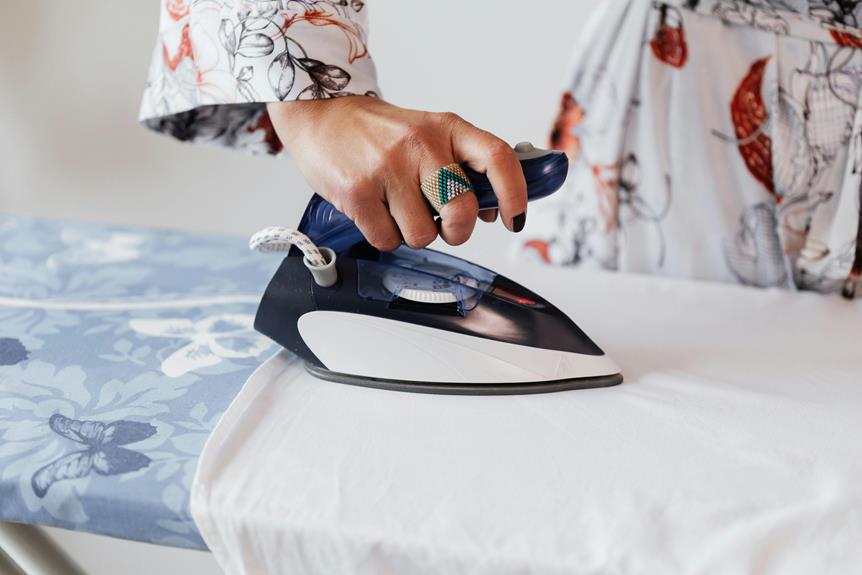When you're looking to remove those stubborn fabric creases, using a steamer can be a game changer. You'll want to start by selecting the right steamer that meets your needs, which can make a significant difference in the process. Before you even plug it in, preparing your fabric properly is crucial to achieving the best results. Once you've got everything set up, you'll find that applying steam effectively requires some technique. But what happens if you encounter challenges along the way? Understanding those nuances can truly elevate your steaming game.
Table of Contents
Key Takeaways
- Choose a steamer with high steam output and quick heat-up time for efficient wrinkle removal.
- Inspect fabric for stains and care instructions, pre-wash for better steam results.
- Hold the steamer 6 inches away from the fabric and move in a downward motion for even distribution.
- Use different steam settings based on fabric type; higher for cotton, lower for silk.
Choosing the Right Steamer
When choosing a steamer, consider factors like steam output, heat-up time, and portability to find the one that best suits your needs.
A steamer with high steam output can quickly tackle stubborn creases, making your steaming process more efficient. Look for models that offer adjustable steam settings, allowing you to customize the steam intensity based on the fabric you're working with.
Next, pay attention to heat-up time. A steamer that heats up quickly saves you valuable time, especially when you're in a rush. Many modern steamers can be ready in as little as 30 seconds, so prioritize those options.
Portability is also crucial, especially if you plan to use the steamer while traveling or for quick touch-ups. Lightweight, compact steamers are easier to handle and store. Some even come with travel bags for added convenience.
Preparing Your Fabric
Before you start steaming, you should choose the right fabric type for the best results.
Pre-washing your fabric can also help remove any residual dirt or oils that might affect the steaming process.
Getting these steps right will set you up for success in removing those pesky creases.
Choose Appropriate Fabric Type
How can you ensure your fabric is suitable for steaming?
First, check the fabric content. Natural fibers like cotton, linen, and wool generally respond well to steam, helping to release creases effectively. Synthetic fabrics, such as polyester or nylon, can also be steamed but require caution. They may melt or become damaged if exposed to high heat.
Next, consider the weight of the fabric. Lightweight fabrics typically benefit from steaming, while heavier materials might need a bit more time and technique. If you're unsure, always start with a small, inconspicuous area to test how the steam affects the fabric.
Additionally, look for any care labels that specify steaming instructions. Some fabrics, like silk or delicate blends, might have special requirements. If the label says “do not steam,” it's best to heed that warning to avoid damaging your garment.
Pre-Wash for Best Results
Pre-washing your fabric can significantly enhance the steaming process by removing any residual finishes that may inhibit wrinkle release. Before you even think about steaming, you should give your fabric a quick wash. This step is crucial, especially for new materials that often come treated with chemicals. These treatments can make it harder for the steam to penetrate the fibers effectively.
When you pre-wash, use a gentle detergent and the appropriate water temperature for your fabric type. This will help lift off any finishes while also prepping the fibers to respond better to steam. After washing, don't forget to dry your fabric properly. Air drying is best for delicate materials, but if you're using a dryer, make sure to select a low heat setting to avoid any damage.
Once your fabric is clean and dry, it's ready for steaming. You'll notice that the wrinkles come out more easily and efficiently. So, take the time to pre-wash your fabric; it's a simple step that can make a significant difference in achieving smooth, crease-free results.
Setting Up the Steamer
To get started with steaming your fabric, you need to choose the right steamer for your needs.
Make sure you prepare your fabric properly to achieve the best results.
Once you've got everything sorted, you'll be ready to tackle those pesky creases.
Choosing the Right Steamer
When selecting the right steamer, consider factors like steam output, heat-up time, and tank capacity to ensure it meets your fabric care needs.
A steamer with a high steam output will effectively remove creases, while a quick heat-up time means you won't have to wait long to get started. Look for a model that heats up in under a minute for optimal efficiency.
Tank capacity is another crucial aspect. A larger tank allows for longer steaming sessions, which is especially useful if you're tackling multiple garments. However, keep in mind that a bigger tank can make the steamer heavier and less portable.
You should also consider the type of steamer. Handheld steamers are great for quick touch-ups and are easy to store, while standing steamers often provide more power and stability for larger items like curtains or suits.
Preparing Your Fabric Properly
Before you start steaming, make sure your fabric is clean and free of any stains that could set in during the process. Prepping your fabric properly ensures the best results when removing those pesky creases. Take a moment to inspect your garment closely.
Here's what you need to do:
- Check for stains: Look for any spots or marks. If you find any, treat them with a suitable stain remover before steaming.
- Read care labels: Different fabrics have specific care instructions. Ensure your fabric can withstand steaming without damage.
- Hang or lay flat: If possible, hang your fabric on a sturdy hanger or lay it flat on a clean surface. This allows for better steam penetration and makes it easier to work on.
Once you've prepared your fabric, you're ready to set up your steamer. Fill the water tank, plug it in, and let it heat up. Keep a spray bottle of water handy for stubborn wrinkles.
With these steps completed, you'll be well on your way to achieving wrinkle-free fabric!
Steam Application Techniques
Using steam effectively requires you to hold the steamer at the right distance from the fabric for optimal results. Generally, keeping the nozzle around 6 inches away works best, allowing the steam to penetrate the creases without saturating the fabric. As you steam, move the nozzle slowly in a downward motion. This helps distribute the steam evenly and lifts the fabric fibers.
To help you remember the techniques, here's a quick reference table:
| Technique | Description | Best For |
|---|---|---|
| Vertical Steaming | Hold the steamer upright and move downwards | Drapes and curtains |
| Horizontal Steaming | Position the steamer horizontally | Shirts and blouses |
| Spot Treatment | Focus the steam on specific areas | Collars and cuffs |
| Tension Technique | Pull the fabric taut while steaming | Slacks and skirts |
| Continuous Motion | Keep the steamer moving for even results | All fabric types |
Tips for Different Fabrics
Different fabrics require specific steaming techniques to achieve the best results, so knowing how to adjust your approach can make a significant difference. Here are some tips for steaming different types of fabrics:
- Cotton: For cotton, you'll want to use a higher steam setting. Hold the steamer about 6 inches away and work from top to bottom. Pay extra attention to seams and collars for a crisp finish.
- Silk: When dealing with silk, use a lower steam setting. Keep the steamer at least 8-10 inches away to prevent water spots. Gently glide the steamer over the fabric, letting the steam relax the fibers without direct contact.
- Wool: Wool is a bit sturdier, so you can use a medium steam setting. Hold the steamer slightly closer, about 5-6 inches away. Steam in a downward motion to help reshape and smooth out any creases effectively.
Maintaining Your Steamer
Regularly cleaning and maintaining your steamer ensures it operates efficiently and lasts longer.
Start by emptying the water tank after each use to prevent mineral buildup. If you notice white deposits, use a mixture of equal parts water and vinegar to clean the tank. Fill it halfway, let it sit for about 30 minutes, then rinse thoroughly with water.
Next, check the steam nozzle for any clogs. You can do this by running hot water through it or using a small pin to dislodge any debris.
Make it a habit to inspect the power cord for damage, too. A damaged cord can be a safety hazard, so replace it if necessary.
Store your steamer in a cool, dry place, and avoid wrapping the cord tightly around the unit, as this can lead to wear and tear.
If your steamer has a removable filter, replace it according to the manufacturer's instructions to keep the steam flow optimal.
Troubleshooting Common Issues
Even with proper maintenance, you might encounter some common issues while using your steamer that can affect its performance. Here are a few troubleshooting tips to help you resolve these problems and get back to removing those pesky creases.
- No Steam Output: If your steamer isn't producing steam, check the water tank. It should be filled to the designated line. Also, ensure the steamer is plugged in and heated adequately. A quick reset may help, too.
- Leaks: If you notice water leaking from your steamer, this could be due to filling the tank beyond the maximum line. Make sure to only fill it to the appropriate level. Also, inspect the hose and connections for any damage.
- Weak Steam: If the steam is weak, mineral buildup might be the culprit. Descale your steamer regularly using a mixture of vinegar and water. This will help maintain optimal performance and ensure a strong steam output.
Frequently Asked Questions
Can I Use a Steamer on Delicate Fabrics Like Silk?
You can use a steamer on delicate fabrics like silk, but be cautious. Hold the steamer at a distance to avoid direct heat. Test on a small area first, ensuring it doesn't damage the fabric.
How Long Does It Take to Remove Creases With Steam?
It usually takes just a few seconds to remove creases with steam, depending on the fabric type and crease depth. You'll notice immediate results as you glide the steamer over the material.
Is Steaming Safe for Upholstery and Curtains?
Yes, steaming's generally safe for upholstery and curtains, but it's smart to check the fabric care labels first. Always test on a small, hidden area to ensure there's no damage or discoloration.
What Should I Do if the Steamer Leaks Water?
If your steamer leaks water, check the water level and ensure it's not overfilled. Inspect for any clogs or damage in the hose. Regular maintenance can prevent leaks and ensure your steamer works properly.
Can I Add Essential Oils to the Water for Fragrance?
Yes, you can add essential oils to the water for fragrance. Just make sure to use only a few drops, so it doesn't clog the steamer or affect its performance. Enjoy the pleasant aroma while steaming!
- The Manufacturing Process of Nonwoven Polypropylene - July 11, 2025
- Is Suede Considered a Nonwoven Material? - July 11, 2025
- Is Silk a Nonwoven Fabric? - July 11, 2025







